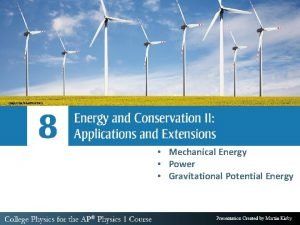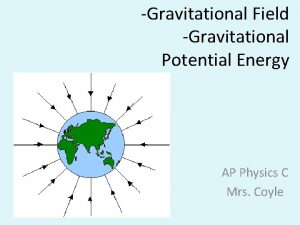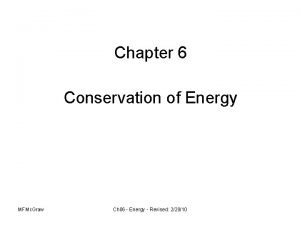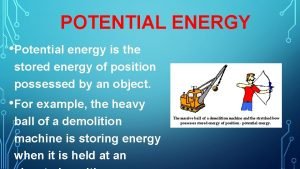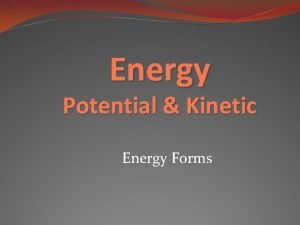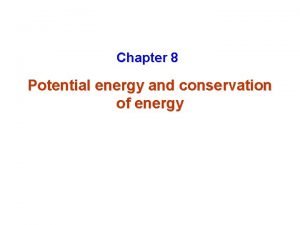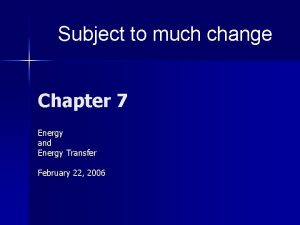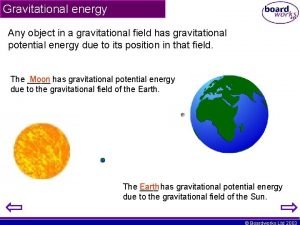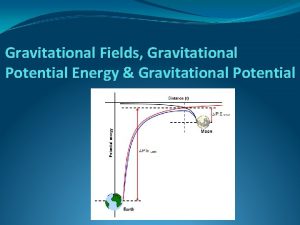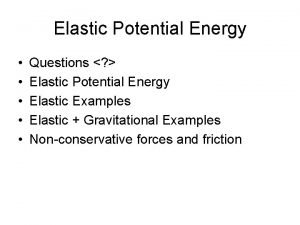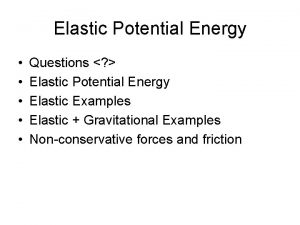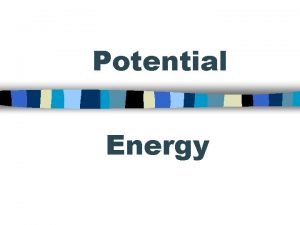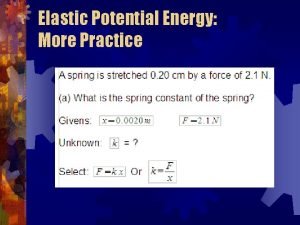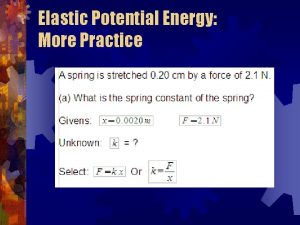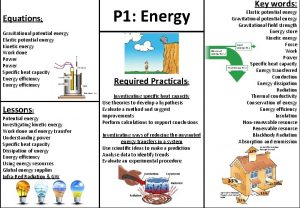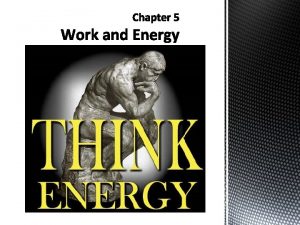Potential Elastic and Mechanical Energy Gravitational Potential Energy












- Slides: 12

Potential, Elastic, and Mechanical Energy

Gravitational Potential Energy � It takes work to lift a mass against the pull (force) of gravity � The force of gravity is m·g, where m is the mass, and g is the gravitational acceleration � F = mg (note similarity to F = ma) � g = 9. 81 m/s 2 on the surface of the earth � Lifting a height h against the gravitational force requires an energy input (work) of: E = W = F ·h = mgh ∴ PE=mgh UCSD: Physics 8; 2005 Spring 2005 2

First Example of Energy Exchange �When the boulder falls off the cliff, it picks up speed, and therefore gains kinetic energy �Where does this energy come from? ? from the gravitational potential energy �The higher the cliff, the more kinetic energy the boulder will have when it reaches the ground mgh h becomes Energy is conserved, so ½mv 2 = mgh Can even figure out v, since v 2 = 2 gh ½mv 2 UCSD: Physics 8; 2005 Spring 2005 3

Examples of Gravitational Potential Energy �How much gravitational potential energy does a 70 kg high- diver have on the 10 meter platform? mgh = (70 kg) (10 m/s 2) (10 m) = 7, 000 kg·m 2/s 2 = 7 k. J �How massive would a book have to be to have a potential energy of 40 J sitting on a shelf two meters off the floor? mgh = m (10 m/s 2) (2 m) = 40 J so m must be 2 kg UCSD: Physics 8; 2005 Spring 2005 4

Springs �Hooke’s Law: The force exerted by a spring is proportional to the distance the spring is stretched or compressed from its relaxed position. Ø FX = - k x Ø x = displacement from the relaxed position (m) Ø Spring stretched or compressed Ø k = the constant of proportionality. It is best known as the spring constant (N/m)

Relaxed Position

Simple Harmonic Motion �occurs when the force F acting on an object is directly proportional to the displacement x of the object, but in the opposite direction.

Examples of Simple Harmonic Motion

Elastic Potential Energy 2 PE =½kx elastic Ø x = displacement from the relaxed position (m) Ø k = the spring constant. (N/m) Ø PEelastic = Elastic Potential Energy or work stored in the spring. (J)

Sample Problem 5 D The spring constant of a car’s front coil spring is 1. 8 X 10 5 N/m. When a front tire of the car rolls over a rock, the spring is compressed 15 cm from its equilibrium position. How much potential energy is store in the spring at the point of maximum compression?

Law of Conservation of Energy �It cannot be created nor destroyed. �It can change form �The total amount of energy in an isolated system does not change �Mechanical Energy ME= KE + PEg (all forms of PE) �MEi = MEf

Sample 5 E A cliff diver dives from a height of 15 m above the water surface. How far is he from the water when his speed is 12 m/s? Neglect air resistance. http: //mycollegeroadtrip. com /spring-break/mazatlanmexico
 Gravitational potential energy formula
Gravitational potential energy formula Gravitational potential energy vs kinetic energy
Gravitational potential energy vs kinetic energy Gravitational potential energy formula between two objects
Gravitational potential energy formula between two objects Gravitional energy
Gravitional energy Types of energy
Types of energy Find mechanical energy
Find mechanical energy Gravitational potential energy
Gravitational potential energy Mechanical energy examples
Mechanical energy examples Gpe=mgh
Gpe=mgh Thermal energy formula
Thermal energy formula Formula of potential energy
Formula of potential energy Kinetic energy numericals
Kinetic energy numericals Gravitational potential energy
Gravitational potential energy


